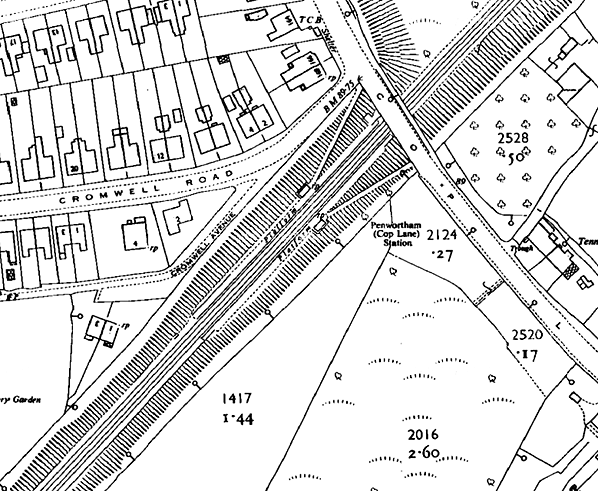
Station Name: PENWORTHAM (COP LANE) [Source:Tony Graham &
Paul Wright]
old4.jpg) Penwortham (Cop Lane) station looking south-west in 1950. The station’s basic facilities
are clearly shown. Copyright photo from Stations UK   1933 1:2,500 OS map clearly illustrates the simple nature of the facility. The reason why the LYR provided it can be seen from the nearby housing developments. The station was originally called Cop Lane Halt.
 1960 1:2,500 OS map. From 30 March 1940 the station had been named Penwortham Cop Lane as shown on this map.
old5.jpg) Penwortham Cop Lane looking south-west c.1950s
old18.jpg) Looking north-east towards Cop Lane from the up platform in January 1963.
Photo from John Mann collection old1.jpg) Penwortham (Cop Lane) station looking north-east from the western end of the up (Southport-bound) platform in the early 1960.
old6.jpg) On a glorious summer afternoon in July 1963 Stanier 2-6-4 tank No. 42494 rolls into Penwortham (Cop Lane) station with the 5:30 pm Preston - Southport service, collecting some late day-trippers apparently brought out by the fine weather.
Photo by Alan Castle old11.jpg) Although prolific on other routes in the Southport and Preston areas by this time - and particularly so in East Lancashire - no diesels of any description were ever used on regular service trains over the WLR. DMUs and Brush Type 2s sporadically appeared on inter-regional excursions, generally originating in Yorkshire, but even this was a relatively rare occurrence. On Sunday 9 August 1964 a Scottish Region 6-car 'Swindon Inter-City' unit, a type more accustomed to the hilly road from Glasgow to Stranraer, was used throughout for a day excursion from Ayr to Southport Chapel Street, organised in connection with the 'Kilmarnock Grozet Fair'. With passengers fully apprised of the delights of Southport, this view shows them back on board with the train making good headway on its lengthy return journey, here seen passing non-stop through Penwortham (Cop Lane) station.
Photo by Alan Castle old12.jpg) On a sunny, summer Sunday morning a dozen or so day-trippers, intent upon an outing to the seaside, are regarded with envy by the crew of Lostock Hall's Fairburn 2-6-4T No. 42158 as it draws the 6 coaches of the 10:12 am Preston - Southport service alongside the wooden platform. Built at Derby works and entering service on 2.7.1948, 42158 had a working life of just over 16 years and 9 months, being withdrawn on 24.4.1965 from Lostock Hall shed and cut up at Cashmores of Great Bridge.
Photo by Alan Castle old13.jpg)
On this occasion with no custom to offer, Penwortham (Cop Lane)'s long-serving and very amenable porter-cum-ticket clerk, Frank Taylor, awaits the arrival of the 6:12 pm commuter service from Preston to Southport. Cop Lane, like Longton Bridge, comes under the control of the stationmaster at New Longton & Hutton and, in the deep cutting well below the public highway, the single member of staff on duty here might feel particularly isolated. Frank, however, lived close to Middleforth Junction, a short distance away; as there was no electricity supply in the booking office, in the sometimes lengthy intervals between trains he found it convenient to nip home on his motor-cycle for a crafty ‘cuppa’. Indeed, there were occasions in his absence when the photographer (who had become a close friend) was deputised to collect tickets on his behalf from any alighting passengers. As a consequence of this, it can now be revealed after the passage of so much time that this person now has a ticket collection to be admired! 75048 was built in 1953 to Riddles' Standard Class 4, 4-6-0 design at Swindon works. It entered service in the October at 24A, Accrington shed until November 1955, when it moved to 27A, Bank Hall. Following spells at Chester, Croes Newydd and Lostock Hall, it was transferred to 10A, Carnforth in June 1967 from where it was withdrawn in August 1968 and scrapped by Campbells of Airdrie in November of that year.
Photo by Alan Castle old15.jpg) On the very last day BR Standard 2MT 2-6-0 No. 78041 has recruited a larger than usual crowd of admirers (on both platforms) as it rolls slowly to a halt at Penwortham (Cop Lane) with the 2:34 pm Preston - Southport service. The loco is carrying the 10D shed plate for Lostock Hall where it was allocated from June 1964 until withdrawal in May 1965.
Photo by Alan Castle old16.jpg) The scene of destruction at Penwortham (Cop Lane) in January 1965, only 19 weeks after the passage of the last train. Due to the high fire risk from the all-timber construction, official vandalism has precluded the informal vandalism which would have sealed the fate of the closed station. Today the lanes of the Penwortham bypass sprawl across the site; all traces that a railway ever ran here have been totally and, very efficiently, obliterated.
Photo by Alan Castle 2.jpg) The site of Penwortham (Cop Lane) station in August 1984 during construction of the
Penwortham bypass. Photo by John Mann 1.jpg) The site of Penwortham Cop Lane station looking south-west in July 2011. All traces of the station had been lost under Penwortham bypass. This photograph was taken from the same viewpoint as the two pictures above.
Photo
by Paul Wright
 Home
Page Home
Page
|
1.jpg)



.gif)
4.jpg)
6.jpg)